| Columns Retired Columns & Blogs |
I don't see a link to Page 2 of this article. Am I too early?
I used DRA Labs' MLSSA system and a calibrated DPA 4006 microphone to measure the Quad ESL-2912's frequency response in the farfield, and an Earthworks QTC-40 for the nearfield responses. My estimate of the Quad's voltage sensitivity was approximately 84dB/2.83V/m, somewhat lower than the specified 86dB. Fig.1 shows how the ESL-2912's impedance magnitude and electrical phase angle vary with frequency. It's basically identical to that of the ESL-2912's predecessor, the ESL-989 (reviewed by Larry Greenhill in November 2002), with a high value in the bass dropping smoothly to a plateau of around 6.5 ohms in the upper midrange, with then a further drop reaching a minimum value of 3.3 ohms at 10kHz. Though the electrical phase angle becomes very inductive between 10 and 20kHz, the impedance magnitude in this octave is high, mitigating any drive difficulty.
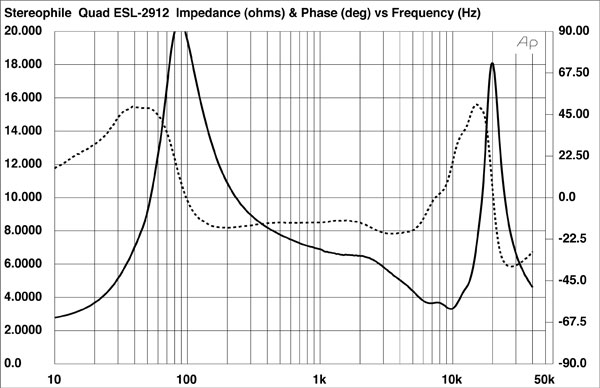
It's always difficult to assess the acoustic behavior of a large panel speaker like the ESL-989. First, the nearfield measurement of the low frequencies will not show the effect of the dipole cancellation, as the antiphase backwave increasingly wraps around to cancel the speaker's direct output with decreasing frequency. The peaked-up bass shown in fig.2 will therefore tend to be more flat in the farfield than it appears in this graph. In addition, when measuring a loudspeaker, it is assumed that the microphone is in the speaker's farfield; ie, several times the largest dimension of the diaphragm. With the largest dimension of the ESL-2912 being its panel height of 54" and my routine distance from the microphone being 50", this assumption is no longer true. As a result, due to the proximity effect, there will be a slight downward trend with frequency in the measured response, as fig.2 also shows.
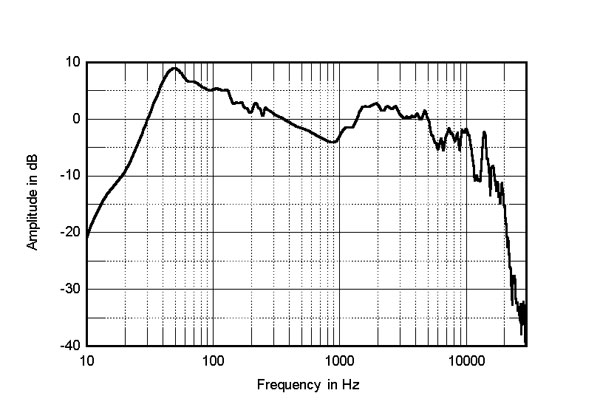
Like the ESL-989's measured response, the ESL-2912's response features a broad depression in the midrange compared with the low treble, while the high treble is first a little peaky, then rolls off sharply above 15kHz or so. In this respect, the ESL-2912 measures less flat than the smaller Quad ESL-2805, which I reviewed in May 2012.
All things being equal, the rather suppressed top two octaves will make the Quad sound somewhat mellow, though I note that RD didn't comment on this aspect of the speaker's high-frequency balance. Fig.3 shows the ESL-2912's lateral dispersion— to make it easier to interpret, actual responses are shown in this graph, rather than, as is usually the case in our reviews, the differences in response off axis. The speaker becomes very directional above 8kHz or so, which will exacerbate the rolled-off top octave in medium to large rooms. However, as RD's room is relatively small, this would have less of a factor in his auditioning, leaving him free to appreciate the Quads' superb stereo imaging, which correlates with the even spacing of the contour lines lower in frequency in this graph. Note also that fig.3 clearly shows the speaker's well-controlled dipolar radiation pattern in the midrange and lower treble, the output 90° to the speaker's sides being suppressed by 30dB. In the vertical plane (fig.4), the speaker's balance doesn't change appreciably over the +15°/–5° window centered on the center of the panel, which is a rather low 33" from the floor.

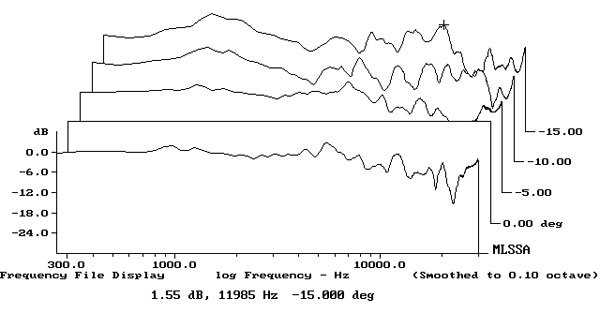
Like every other Quad electrostatic speaker I've measured, the ESL-2912 has a superbly time-coincident wavefront launch. Its step response is shown in fig.5, with what would have been a perfect right-triangle shape disturbed by a second peak 500µs after the first, and a discontinuity just after the 7ms marker, the latter due to the first reflection of the speaker's output from the floor between it and the microphone. In our review of the ESL-989, which had an identical step response, I conjectured that the second peak was due to a reflection of the diaphragm's output from the dustcover. But as the smaller ESL-2805 has an undisturbed step response, I believe that what we see here is the output of the bass panels—which lie above and below the central panels—arriving at the microphone slightly later than the initial arrival.
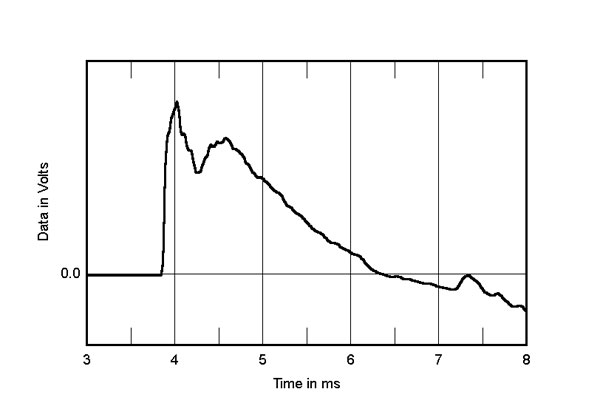
Finally, like that of every other panel speaker I've measured, the Quad ESL-2912's waterfall plot (fig.6) looks hashy, though the initial decay looks relatively clean. But as I explained in our review of MartinLogan's Masterpiece Renaissance ESL 15A electrostatic speaker in January 2017, I suspect that though the average motion of the diaphragm reacts in a linear manner to the drive signal, the panel actually behaves in a chaotic manner (footnote 1). In effect, the panel "shimmies" as it moves—and that, together with local interference from multiple sources arriving at the microphone, gives rise to the messy-looking waterfall plot.
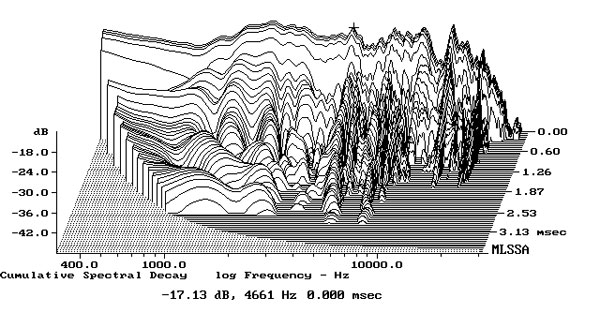
Given how closely the ESL-2912's measured performance resembles those of the other Quad speakers we've reviewed, and that all of those earlier models were very well received by our reviewers, I'm not surprised that RD liked this speaker as much as he did.—John Atkinson

I don't see a link to Page 2 of this article. Am I too early?

I see it. (Just replying because I want to see if I can.)


Lovely review of a lovely speaker. David Janzen (son of Arthur Janszen who was the main creator of the KLH Nine I believe) has facilities to fix and upgrade KLH Nines and is effectively re-manufacturing these wonderful speakers. With his unique position and understanding of these speakers he has also created, manufactures and sells his own Hybrid electrostatic speakers, the Valentina (bigger) and the Carmelita (smaller). Both of these wonderful speakers are still much easier to accommodate than most ESL monsters including the Quads, and have a combination of electrostatic magic, solid and extended bass, integration between dynamic and electrostatic elements and cosmetic home acceptability that are simply the best I've heard. So much so that I have a pair in the UK! David is in Ohio and his janszenloudspeaker.com operation / website is easy to find. He is also one of the nicest guys you could possibly interact with... Enough praise for one comment I believe!!!

Sorry - it's Janszenaudio.com although the other link usually gets you there...
Looked up the old KLH 9 review from many years back and you can see the high regard that JGH had for Janszen as he/his products are mentioned at least twice.

The photos accompanying this review are quite remarkable. Did Quad supply them? Did Stereophile shoot them? The photographer deserves kudos, and Quad must be quite pleased that the speakers' excellent fit and finish are so apparent.

The photos accompanying this review are quite remarkable. Did Quad supply them? Did Stereophile shoot them?
The photo on the cover of the August issue and on p.49 were taken by our regular photographer, Eric Swanson. The other photographs of the speakers were supplied by Quad's US distributor. Th photo of the speakers in Robert Deutsch's listening room was taken by Mr. Deutsch.
John Atkinson
Editor, Stereophile

I love ESL's, and have owned original Quads for over a quarter century. While a great loudspeaker, the current Quad has a lot of excellent competition, from the likes of SoundLab, Martin-Logan, Kingsound, and especially Sanders Sound Systems. I say especially SSS because that loudspeaker is imo a considerably better ESL than the Quad, and costs less. I'm afraid Quad's time has passed.

I am trying to rearrange my room to be more sound friendly, is it possible to get the measurements of Mr. Deutsch's room? It looks similar and I appreciate him sharing the pic. Similar room pics (space allowing of course) might add nice context to any review.

My listening room's dimensions are 16'X14'X7.5. The photo was taken with a fisheye lens (Sigma 15mm on a Canon 6D) and "de-fished" in software to reduce the fisheye distortions. For another photo of the same room, see https://www.stereophile.com/content/wilson-audio-specialties-sabrina-loudspeaker-page-3

I have heard Magnepan speakers a bit, and Martin-Logan once and have always enjoyed the lifelike sound of ESLs. I'm not familiar with Quads or the other brands mentioned by BDP24.
How do the Quads (or others) compare to Magnepan?
Thanks!

Like others, I throughly enjoyed Robert Deutsche's review. I have been an electrostatic audiophile for years. What I have retained in my current collection:
1) The original Martin Logan Full Ranger ( production prototype CLX).
2) Stax-8x ELS
3) One-off modified Quad 2805's
Re the ML, the prototype was voiced by Gail Sanders to match the sound of the best Stax ELS headphones of the day, and was a dramatically better sounding speaker than the tamed down version which was produced. The prototype dipped below .2 ohms and had wild phase shifts. It presented a nearly impossible load to drive at the time and was essentially a short circuit. Even so, it sounded spectacular on the 1977 Yamaha B-1- an all vertical FET amp which utilized static induction transistors and was way ahead of its time.
Re the Stax, only a few pairs of these were ever imported to the US and no other ELS I am aware of ever tested as linearly as they do over full range. Big, solid panels comprised of 8 elements per side. They are a marvelous speaker but dominate normal rooms.
The specially modified Quads are what I normally listen to. In Robert's article, he wrote: "Since 2013, all Quad ESL models have been made in China; my impression—based on talking to owners and people in the industry—is that, following some teething problems, the reliability of the made-in-China ESLs is greatly improved."
The users I am familiar have said the opposite. And that whatever faults or serviceability issues applied to the UK-made units, the products coming from China are not as well made and result in many more issues. Possibly what Robert is referring to is service issues with the old US importer, as there were many in the latter days. However, regarding Chinese 2805's or 2812's I bought a pair of 2805's (they sound and test better than 2812's) but they malfunctioned immediately after shipping. I had wanted to have them rebuilt and upgraded anyway, so hired Kent McCollum to do so. Kent is very good at this. I specified all rebuilt UK components and we tossed the Chinese material. We also applied all the upgrades to the circuitry that have proven effective. So it's essentially state of the art UK sourced equipment with all practical upgrades. The result is a superb speaker, and after break-in the best Quad that Kent or I had heard. For what it's worth, Kent will rebuild either UK or Chinese Quad components but will not warranty any of the Chinese products. He bases this policy on real world experience.
Possibly the Chinese have made dramatic improvements in their materials, components, and workmanship over the past 4-5 years. That would be good. I do not know if this is the case or not, but wanted to share my experience.
-Gary

Thanks for taking the trouble to provide such a detailed account of your successful repair/upgrade experience with Kent McCollum at Electrostatic Solutions.

Alas, as appealing as these speakers are, every pair I've seen in the market is either on its way to the repair shop or just arrived therefrom.
Separately, the listening room depicted isn't remotely adequate for judging the sound of speakers like these.